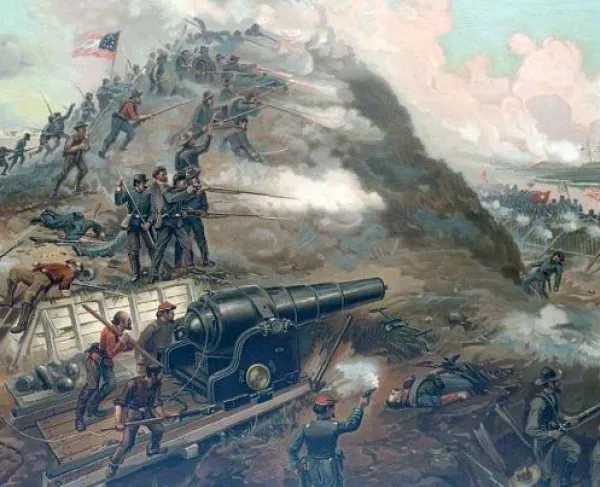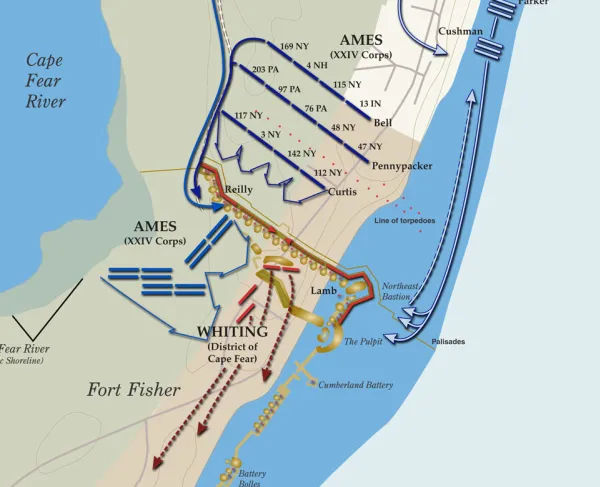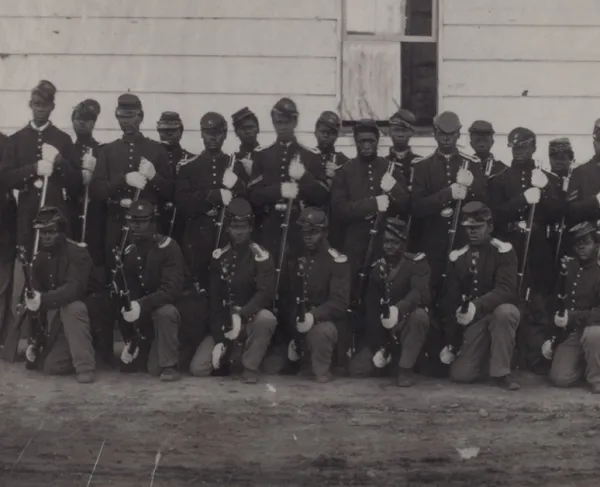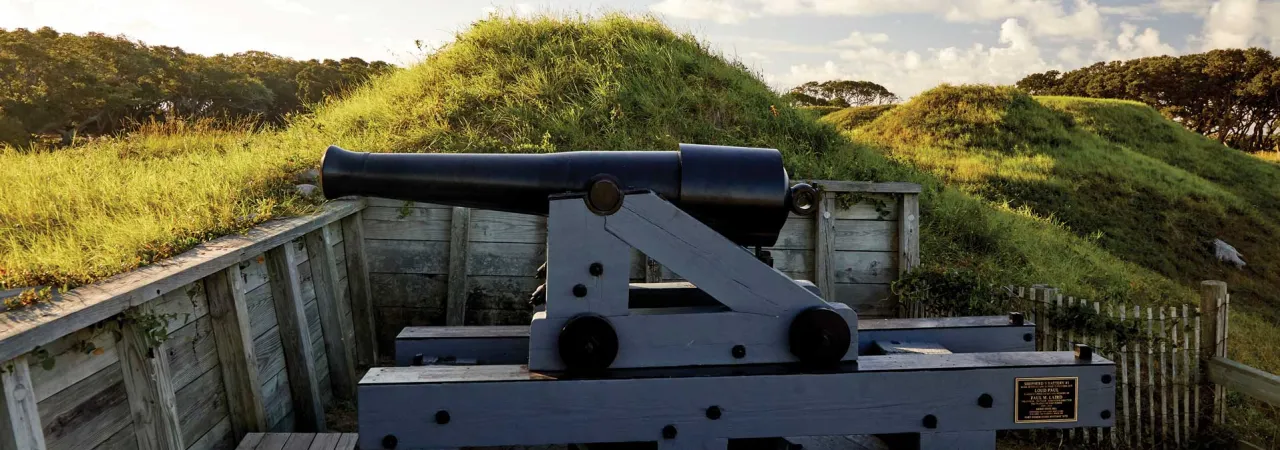
A rifled and banded 32-pounder cannon at Shepard's Battery, Fort Fisher State Historic Site, Kure Beach, N.C.
After the fall of the formidable Fort Fisher, the Confederates surrendered their arms to the Federal forces. But one sword would carry special weight and can even be seen at Fort Fisher State Historic Site.
After the fall of the formidable Fort Fisher, the Confederates surrendered their arms to the Federal forces. But one sword would carry special weight and can even be seen at Fort Fisher State Historic Site.
Within weeks of the Civil War’s outset, Confederate artillery positions were placed near the mouth of the Cape Fear River to protect the vital trade route to Wilmington. Steadily improved with earthen walls designed to absorb heavy ordinance, Fort Fisher grew to become the largest fortification in the Confederacy — a veritable Gibraltar that kept Union fleets and armies at bay until late 1864.
The first battle for Fort Fisher began on Christmas Eve. Union naval artillery knocked out some Confederate guns long enough to land infantry on the beach, but the assault was unsuccessful. Rather than follow his orders to besiege the fort, Union General Benjamin Butler withdrew his stranded troops and was removed from command for disobedience.

On January 12, the Union moved again, the Second Battle of Fort Fisher likewise beginning with a naval attack. By the following day, Union command deemed the fort weakened enough to land infantry, which isolated the works that same day. Naval bombardment continued unabated, and a second shore force of sailors and Marines landed on the 15th in preparation for a two-pronged attack that afternoon.
As the fighting progressed, Maj. Gen. William Whiting, Col. William Lamb and Maj. James Stevenson were rendered “hors de combat” and incapacitated, devolving Confederate command to Maj. James “the Tarantula” Reilly. Faced with overwhelming odds, Reilly and about 600 refugees migrated to a cul de sac, “where I [Reilly] expected to reform our shattered ranks, and to be in a position to engage the enemy under more favorable conditions.” Alas, upon arrival, the Tarantula was surprised to discover the earthwork abandoned, the battery evacuated, the guns spiked and every vessel taken. Having exhausted his options, real estate and whatever luck the Irish are said to possess, the savvy veteran with two decades of army service had arrived at the mortifying and penultimate moment of his military career.
It was no accident that the climactic scene in this Southern tragedy was played out at Battery Buchanan, the last major engineering project undertaken on Confederate Point, situated at the terminus of the peninsula overlooking New Inlet and ancillary to Fort Fisher – the largest seacoast fortification in the Confederacy. The lovestruck engineer who submitted the design christened it “Augusta Battery” for his sweetheart, before Whiting, the district commander, quashed the sentimentality and officially dubbed it “Battery Buchanan” in honor of Admiral Franklin Buchanan — the South’s only full admiral, gallant hero of Mobile Bay and commander of the ironclad C.S.S. Virginia on the one day when that ship ruled the seas like Poseidon.
The admiral’s namesake, an elliptical, 43-three-foot-high earthwork, boasted four heavy smoothbore cannon, two 10-inch Columbiads and two 11-inch Brookes, and occupied a detached and isolated position that seemingly rendered it impregnable. A “no man’s land” of flat sand afforded a clear field of fire for nearly a mile in advance, while in the rear yet of paramount importance was a wharf that facilitated the mooring of river steamers. This was manned by the Confederate navy and commanded by Capt. Robert Chapman. Post commander Lamb described it as, “a citadel to which an overpowered garrison might retreat, and with proper transportation, be carried off at night, and to which reinforcements could be safely sent under the cover of darkness.”
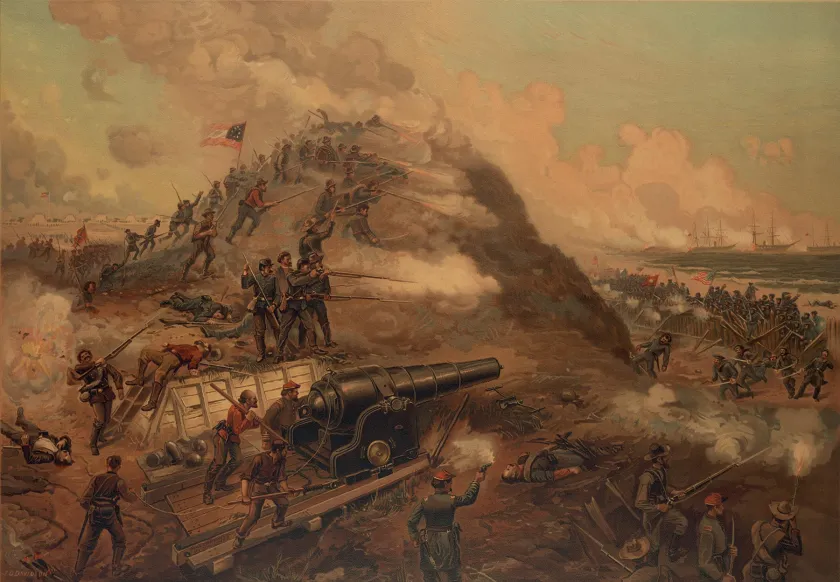
But at 10:00 p.m., on the cold, moonlight night of Sunday January 15, 1865, there was no help in sight. With three Yankee regiments bearing down on them and a mile-wide river to their back, the hopelessness of the situation was evident. As Reilly “observed the [enemy’s] skirmish line … advancing upon the point,” he and two fellow officers emerged from the shadow of the battery to confront the foe. Three hundred yards out Reilly stopped and “took my handkerchief and placed it on the point of my saber and awaited your coming.” He did not have to wait long.
Later, the wounded and imprisoned Whiting loudly declared that they’d been betrayed, maintaining that the loss of Fort Fisher “is due wholly and solely to the incompetence, imbecility and pusillanimity of Braxton Bragg.” Meanwhile, Reilly, unharmed but a prisoner for the rest of the war at Fort Delaware, placed the onus on Chapman alone: “I thought him too good a soldier to abandon us.” The wounded and captured Lamb split the blame, suggesting that Chapman, “following the example of Gen. Bragg … abandoned us to our fate.”
But finger-pointing was still in the future as the 6th Connecticut, 7th New Hampshire and 27th U.S. Colored Troops regiments converged on the battery. Also there in the vanguard was Capt. Ezra Lewis Moore of the 7th Connecticut – a 27-year-old schoolteacher who’d enlisted as a private, but through a combination of “accuracy and promptness in the office and bravery in the field,” risen to become the brigade’s assistant adjutant general. A comrade remembered that Moore “seems to have been the right man in the right place.” Undoubtedly, Major Reilly would have agreed: “When I surrendered my saber to you it was with a heart of the deepest depression. As a brave soldier you treated us courteously and showed no bravado over our defeat for which accept my sincere thanks.”
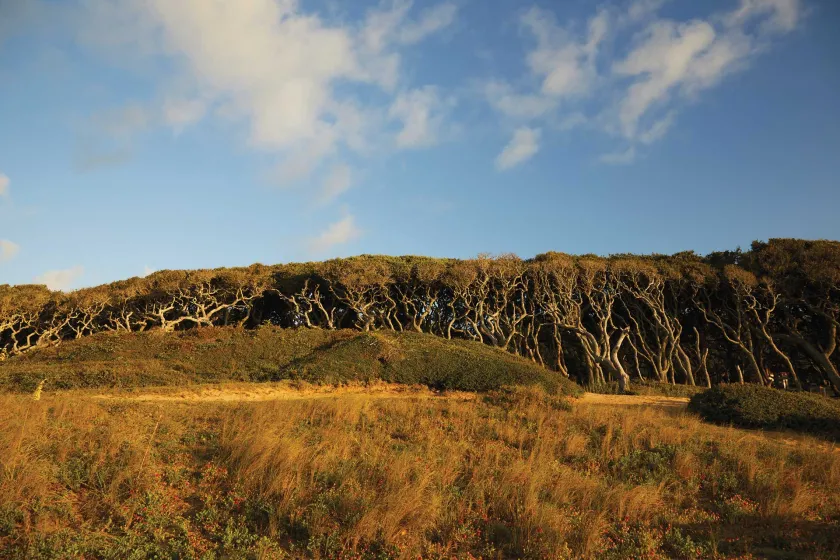
Five and a half weeks after the capture of Fort Fisher, on February 22, 1865, Washington’s birthday, Wilmington fell to Federal forces, and soon after, the new commander of the “Wilmington District,” Maj. Gen. Joseph Hawley, established his headquarters at the Bellamy Mansion on the northeast corner of 5th and Market Streets, accompanied by a bevy of staff officers, including Moore. From early March through much of June, a galaxy of stars both military and civilian illuminated the halls of the mansion. Gens. William T. Sherman and John Schofield, Secretary of the Navy Gideon Welles and Postmaster General William Dennison, Jr., were all visitors. In May, former treasurer of the United States, now Chief Supreme Court Justice, Salmon P. Chase, and his beautiful daughter Kate passed through. During his stay at Federal Headquarters, the judge used Moore’s desk to write a dispatch and inadvertently left his gold pen and silver case behind. Moore wrote that he only discovered it after Chase had departed and, “As he never inquired for it — I retained it as a memento of the visit and have it to this day.”
On October 20, 1893, 28 years after the war, two other former adversaries — Confederate Colonel William Lamb and Federal General Newton Martin Curtis — who had spent the better part of a January afternoon in 1865 attempting to slay one another, returned to revisit Fort Fisher. The next day’s Wilmington Messenger featured a lengthy article detailing their reunion and how Lamb jocularly referred to Curtis as “my friend the enemy.” The piece was clearly picked up by some of the Northern papers because, within the week, an inspired Moore had written a letter to Wilmington’s mayor, seeking Reilly’s whereabouts.
The old major was not hard to find; for many years, he had lived in Wilmington and run the Market Street Ferry. After retirement, he moved across the river to a farm in Brunswick County, where he received Moore’s unexpected and generous correspondence. His response to the unlooked-for gesture was immediate: “Dear Captain, Accept my thanks…. It certainly was a surprise and a pleasure.”
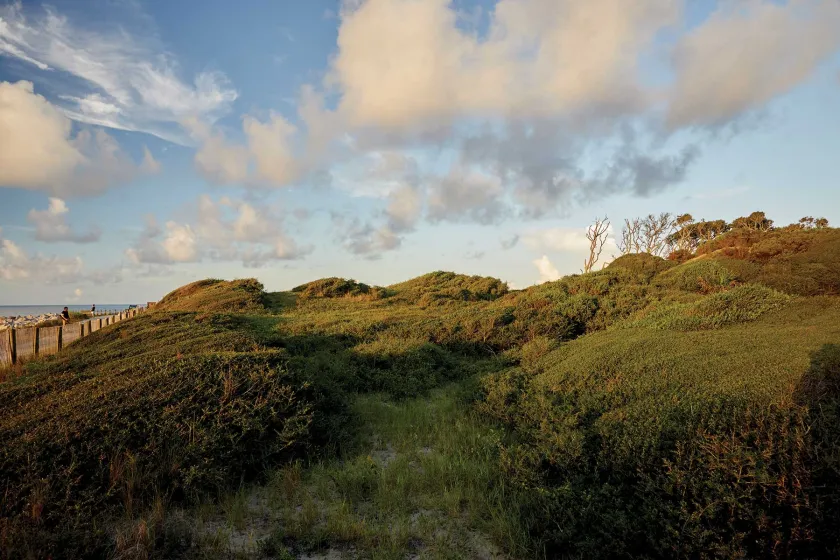
A package from New England soon arrived with a note enclosed: “My Dear Major: I take great pleasure in forwarding … the sword which has been the subject of our recent correspondence. The sword of Fort Fisher.” Reilly’s gracious note of acceptance back to Moore closed with a fraternal invitation, “Captain, if you have the time this winter to come and see me, we will visit the fort and see the ruins of that historic place.” But, alas, there was to be no earthly reunion, as Reilly died the following November.
Today, thanks to the generosity of Reilly’s descendants, that light cavalry saber produced by the Ames Manufacturing Company of Chicopee, Massachusetts, in 1859, is on loan to the state and can be seen at the Fort Fisher Visitors Center. Emblematic of both combat and reconciliation, some would consider it the most pertinent artifact in the exhibit hall.
Indeed, the site owes Captain Moore a great debt for bringing the story full circle with his magnanimous gesture. However, so far as we know, he never gave Chase back his pen.
Related Battles
1,057
1,900
